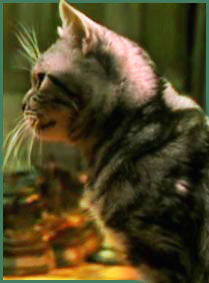|
What is transfiguration?
The art of manipulating matter: changing its
form and composition (Transfiguring), creating it out of thin air or out of matter taken from 'Wizard-space' (Conjuring),
or discorporating it or sending it into 'Wizard-space' for later retrieval (Vanishing).
What kind of a subject is it?
On the scientific front, I'd say Transfiguration
compares most closely to applied advanced quantum or particle physics: fiddling with matter, energy, atomic bonds and alternate
dimensions (i.e. Wizard-space or Hammer-space -- where a Vanished object goes when it disappears). It is not an easy subject.
In addition, students often work with living objects (hedgehogs, mice, birds, and eventually their own physical forms), probably
requiring at least some knowledge of chemistry, biology, anatomy, and neurology.
How is the Animagus transformation different?
According to JKR, an
Animagus transfigures himself into an animal, but keeps his own mind: which is difficult, as the animal's neural structure
is less complex than a human's. An ordinary animal transfiguration does not allow the person to retain his or her faculties:
ergo Malfoy, transfigured into a ferret, was not thinking My father shall hear of this while he was bouncing up and
down, but McGonagall in her cat form was able to read maps and maintain a very human level of concentration and preoccupation.
Self-Transfiguration begins at the sixth-year level, but the Animagus transformation is so taxing that very few people actually
manage it.
What about the Metamorphmagus transformation?
--Or
the Werewolf?
The Metamorphmagus transformation is inborn, instinctive, and practically effortless, requiring little
of the rigorous concentration and exactness demanded of the ordinary Transfiguration student. The werewolf transformation,
on the other hand, is completely involuntary, triggered by factors outside the wizard, and uncontrollable by the wizard. The
Wolfsbane potion prevents the afflicted wizard from losing his mind when he transforms, but the rest of the transformation
cannot be halted by normal magic.
Interesting facts:
- Returning a Transfigured object to its original form is called Untransfiguring.
- The class of object being Transfigured is a major factor in the transformation's level of difficulty. Some classes include
vertebrates/invertebrates, sentient/nonsentient, living/nonliving, and probably other scientific classes such as animal/vegetable/mineral.
- Animagi retain their clothing and any items on their persons during the change. (The POA movie got it wrong.)
- Their physical states as Animagi correspond to their physical states as humans; a wound acquired in one state will carry
over to the other.
- The Animagus transformation is wandless and non-verbal.
- It is possible for another wizard (or two working in tandem) to nullify the transformation, forcing the Animagus back
into human form. This may be a nonverbal incantation; it produces a flash of light, and will not harm a real animal.
|
 |
|
Transfiguration booklist:
A Beginner's Guide to Transfiguration by Emeric Switch (first-year)
Intermediate Transfiguration (third-year)
Guide to Advanced Transfiguration
Theories of Transubstantial Transfiguration (sixth year)
Transfiguration Today (a magazine, POA ch3)
?The Invisible Book of Invisibility (POA ch3)

|
| The Professor in her cat form. |
Is Invisibility a form of Transfiguration?
Yes. Invisibility
seems to involve causing oncoming light to pass around the person and continue on its previous course instead of being reflected
back. Albus Dumbledore, as a former Transfiguration teacher, was known to possess this power. It is not yet known how
a wizard can see if his retinas are invisible.

|
| Transfiguration requires a large body of varied and detailed knowledge. |
|
 |
|
|
 |
|
|
|

